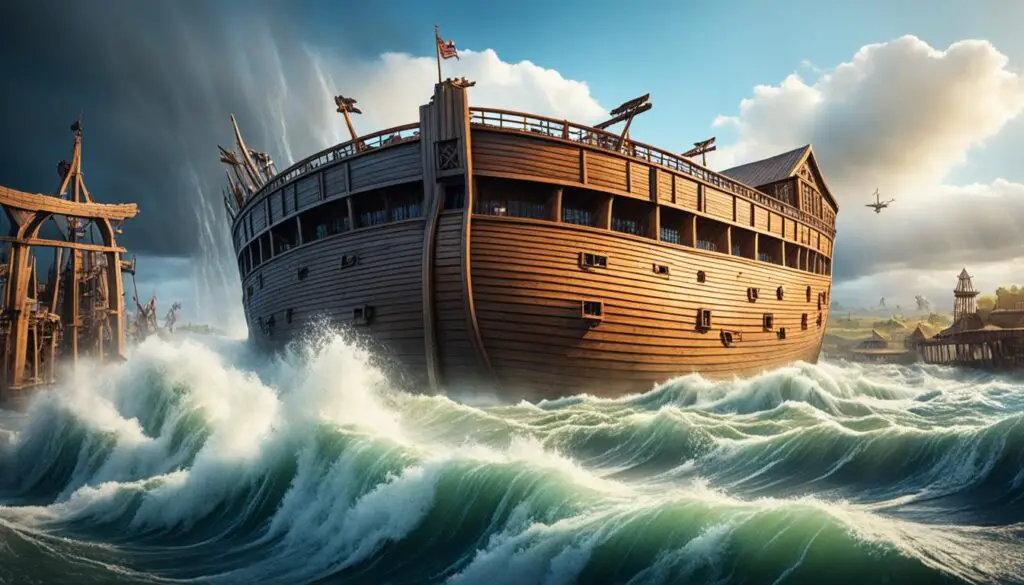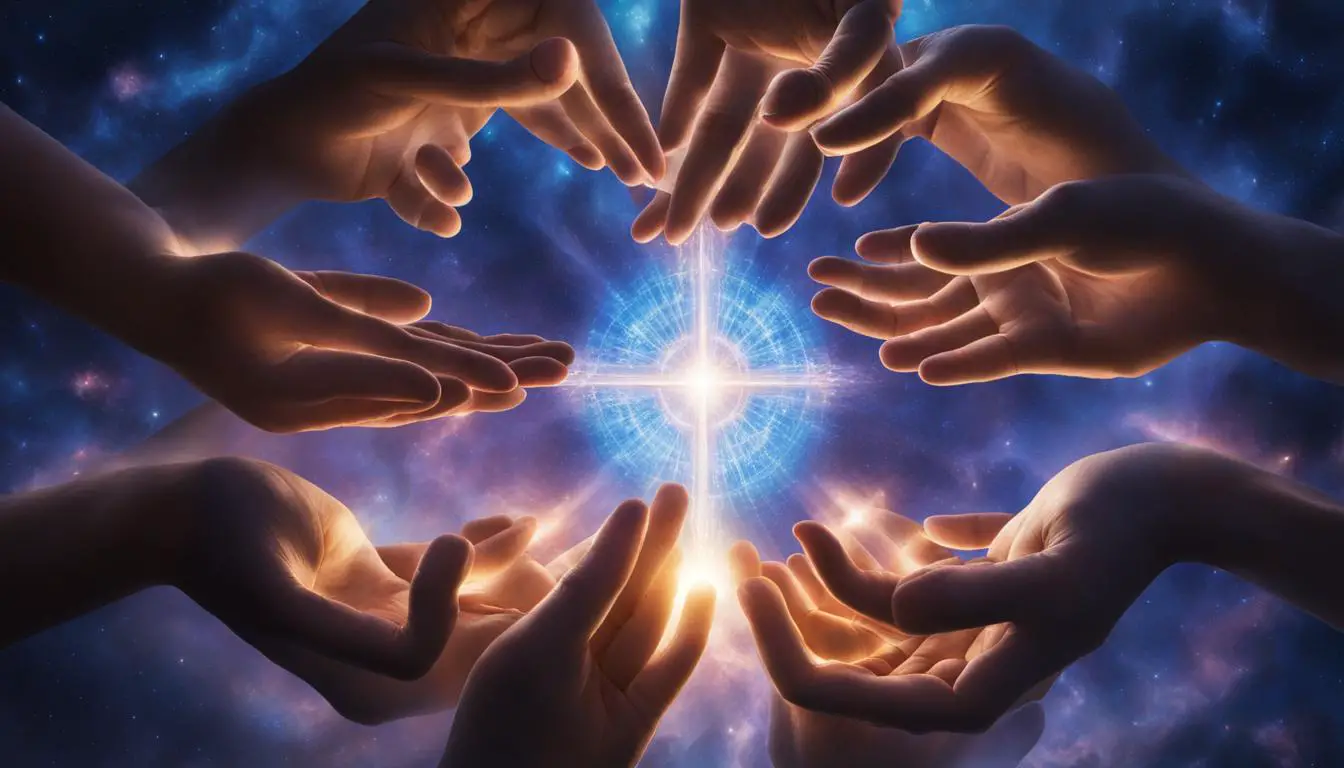Noah, a central figure in the Bible, is known for his role as an ark builder and survivor of the great flood. His story, found in the book of Genesis, showcases themes of faith, resilience, and obedience. Noah’s righteousness and favor with God led to his selection as the chosen one to construct the ark and ensure the survival of life on Earth.
The story of Noah in the Bible recounts how he faithfully followed God’s instructions to build an enormous ark, which was then filled with pairs of animals and his own family. This act of obedience allowed Noah to weather the devastating floodwaters and ultimately emerge as a symbol of hope and renewal.
Key Takeaways:
- Noah, a biblical hero, is known for building the ark and surviving the great flood.
- His story emphasizes faith, resilience, and obedience to God’s commands.
- Noah’s ark served as a vessel to safeguard pairs of animals and his own family during the flood.
- Through obedience and trust, Noah became a symbol of hope and renewal.
- The story of Noah continues to inspire believers, reminding them of the importance of faith and obedience.
The Story of Noah in the Bible
Noah, the son of Lamech, is introduced in the book of Genesis as a righteous man who walked closely with God. His story revolves around the great flood, in which Noah was chosen by God to build an ark and save his family, as well as a representative pair of every species of animals.
When the floodwaters receded, Noah and his family emerged from the ark and offered sacrifices to God in gratitude for their survival. In recognition of Noah’s faithfulness, God established a covenant with him, promising to never again destroy the earth with a flood.
Noah’s story serves as a powerful reminder of the importance of obedience, faith, and trust in God’s plans. His unwavering commitment to following God’s instructions allowed him to become a vessel of hope and preservation in the face of catastrophic destruction.
Additionally, Noah’s role as the caretaker of the animals on the ark showcases his responsibility and compassion towards all creatures. It demonstrates the value of stewardship and the interconnectedness of all living beings.
The Covenant with Noah
“I now establish my covenant with you and with your descendants after you and with every living creature that was with you—the birds, the livestock and all the wild animals, all those that came out of the ark with you—every living creature on earth.” (Genesis 9:9-10)
The covenant God made with Noah symbolizes His faithfulness and eternal love for humanity. It is a promise of protection and renewal, ensuring that the earth will never again be destroyed in such a manner.
Noah’s family, including his sons Shem, Ham, and Japheth, played significant roles in the post-flood era, as they were the forefathers of a new generation. This new lineage would eventually lead to the birth of Jesus Christ, illustrating the continuous thread of redemption throughout biblical history.
Noah’s Righteousness and Faith
Noah’s unwavering righteousness and devotion to God set him apart from the corrupt and sinful society that surrounded him. He serves as a model of faith and obedience, emphasizing the importance of living a righteous life in the midst of adversity and temptation.
Ultimately, Noah’s story teaches us to trust in God’s plans, even when they seem unconventional or challenging. It inspires us to cultivate a deep faith, recognizing that God’s faithfulness and guidance will lead us through the storms of life.
| Noah’s Ark | Noah Bible Story | Noah and the Flood | Noah’s Family |
|---|---|---|---|
| Noah was chosen to build an ark and save his family and animals from the flood. | Noah’s story in the Bible showcases his faith, obedience, and trust in God’s plans. | The great flood, sent by God as a means of divine judgment, was survived by Noah and his family in the ark. | Noah’s family, including his sons Shem, Ham, and Japheth, played important roles in the post-flood era. |
Building the Ark
According to the instructions given by God, Noah embarked on the monumental task of building the ark. The Bible provides specific details about the size and construction materials used for this extraordinary vessel. The ark was not a small boat but rather a substantial structure, designed to withstand the impending Great Flood.
Size of the Ark
The dimensions of Noah’s Ark were truly remarkable. As detailed in the Bible, the ark was 300 cubits long, 50 cubits wide, and 30 cubits high. This translates to approximately 450 feet long, 75 feet wide, and 45 feet high, making it an enormous vessel capable of accommodating pairs of every kind of animal, as well as Noah’s family.
Construction Materials
Noah carefully followed God’s instructions and utilized specific construction materials to ensure the ark’s durability and functionality. According to the Bible, he built the ark using gopher wood, a wood species that has been the subject of much debate and speculation. While the exact nature of gopher wood remains uncertain, it is believed to refer to a strong, resilient type of timber suitable for shipbuilding.
“Noah did everything just as God commanded him.” – Genesis 6:22
While the Bible does not provide explicit details about the construction process, it is likely that Noah enlisted the help of others. Building such a massive ark would have required not only his family’s involvement but also the assistance of skilled workers. The construction of the ark demanded careful planning, strategic organization, and meticulous craftsmanship.
To visualize the scale of the ark, this table provides a comparison between the dimensions of Noah’s Ark and a modern cargo ship:
| Noah’s Ark | Modern Cargo Ship |
|---|---|
| Length: 450 feet | Length: Varies, but commonly exceeds 600 feet |
| Width: 75 feet | Width: Approximately 100 feet |
| Height: 45 feet | Height: Generally less than 100 feet |
| Capacity: Housing animals and Noah’s family | Capacity: Transporting cargo across vast distances |

The construction of Noah’s Ark stands as a testament to his unwavering faith and obedience to God’s commands. Through meticulous planning and precise execution, Noah created a vessel capable of preserving life during the Great Flood.
The Animals on the Ark
One of the most well-known aspects of Noah’s story is the gathering of animals on the ark. In accordance with God’s instructions, Noah took pairs of every kind of animal, as well as seven (or seven pairs) of each kind of clean animal and bird.
Noah’s task as a caretaker involved providing food and tending to the needs of the animals during their time on the ark. While skeptics have debated the feasibility of fitting all the animals on the ark, current research suggests that Noah brought representative pairs of each animal kind, rather than every individual species.
To ensure the animals’ well-being, Noah would have needed to create suitable habitats and attend to their dietary requirements. This would have required careful planning and organization on Noah’s part.
Although there are no specific details provided about how Noah managed the diverse group of animals, it can be inferred that he had an important role as their caretaker, ensuring their survival on the ark.
Animals on the Ark: Example List
| Animal | Quantity |
|---|---|
| Lion | 1 pair |
| Giraffe | 1 pair |
| Elephant | 1 pair |
| Monkey | 1 pair |
| Tiger | 1 pair |
| Leopard | 1 pair |
| Sheep | 7 pairs |
| Chicken | 7 pairs |
| Dove | 7 pairs |

While this list is not exhaustive, it gives an idea of the diversity of animals Noah would have cared for on the ark. It is important to note that the primary purpose of the Flood was not to preserve every species on Earth, but rather to save representative pairs of each kind so that life could be restored after the waters receded.
Conclusion
The story of Noah in the Bible serves as a testament to faith, righteousness, and God’s faithfulness. Noah’s unwavering obedience and trust in God’s instructions allowed him to survive the destructive flood that wiped out the rest of humanity. Through God’s covenant with Noah, a promise of protection and renewal was established.
Noah’s descendants, including Shem, Ham, and Japheth, went on to play pivotal roles in biblical history. In fact, it is through this lineage that Jesus Christ, the central figure of Christianity, was born. Noah’s righteousness and commitment to walking with God set the foundation for generations to come.
Today, the story of Noah continues to inspire believers around the world. It serves as a reminder of the importance of faith and obedience in the face of adversity. Noah’s unwavering devotion and trust in God’s plan enabled him to navigate through the challenges and emerge as a beacon of hope.
As we reflect on the story of Noah, we are reminded of the power of God’s faithfulness and the significance of following His commands. Through Noah’s story, we find encouragement to remain steadfast in our own faith journey, knowing that God is always with us, guiding and protecting us.







